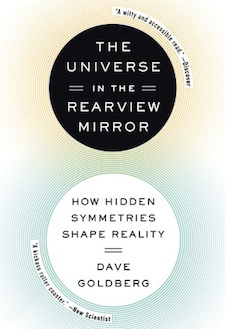By Anna Moyer
What happens when Alice falls through the rabbit hole and into a black hole? Could Alice survive in Antimatter Wonderland? Or build a teleporter? In The Universe in the Rearview Mirror, astrophysicist Dave Goldberg places Alice and companions in hilarious, if unlikely, situations in order to demonstrate how physical laws are established via symmetries. Goldberg illustrates the way in which fundamental order frames the physical on scales ranging from quantum particles to universes and on time periods from fractions of seconds after the Big Bang to the end of the cosmos.
Goldberg’s lively discourse covers a wide array of topics ranging from black holes to teleportation to relativity to the multiverse. Beginning with a discussion of antimatter, Goldberg asks what would happen if every particle in the universe were turned into its antiparticle and the whole thing were viewed in a mirror. As it happens, this so-called “CP transformation” would not result in an identical universe because of the existence of more matter than antimatter. The asymmetry between matter and antimatter is ultimately the reason that something exists rather than nothing, and this chapter leads seamlessly into an examination of entropy and time, the multiverse and why three spatial dimensions seems just right for our existence, and how symmetry laws relate to conservation laws. Passing through relativity, gravity, and elementary particles, Goldberg ends with an analysis of how imperfect symmetries give rise to the laws of physics by balancing order and chaos and how developing a unified theory of deeper symmetries is currently an ambitious goal for physicists.
From the start, Goldberg notes that you do not “have to be a genius to understand the mysteries of the universe” and makes an exemplary effort to explain complex theories in physics to anyone willing to think through the conceptualizations. His commitment to making the field accessible without diluting its scientific content makes reading the narrative a fun and intellectual experience. And while it may be tempting to skip the footnotes, Goldberg’s asides are a stimulating grab bag of wry commentary, compelling trivia, and more detailed qualifications of statements found in the main text. Goldberg’s use of analogies is similarly entertaining – although comparisons to real life objects and phenomena are common in physics textbooks, Goldberg’s examples border the absurd as he likens Kepler’s elliptical orbits to an astronomical turducken of Platonic solids and general relativity to life on a spinning disk ruled by a superintelligent ant named Marie Antoinette. However whimsical, these analogies synergize perfectly with old-fashioned, charming illustrations to illustrate abstract concepts in a coherent manner. Goldberg also makes cultural references, and although allusions to fantasy leagues and the TARDIS may make the narrative more relatable, they create the potential to alienate readers who are unfamiliar with a variety of sci-fi and pop culture trends.
Many great physicists are acknowledged for their contributions to the study of symmetry, but Goldberg devotes an entire chapter to Emmy Noether, who was an ingenious German mathematician in the early twentieth century. Despite her relative anonymity among modern audiences, Noether’s Theorem unifies physical laws by proposing that each symmetry corresponds to a conservation law. For instance, rotational invariance corresponds to the conservation of angular momentum while time invariance corresponds to the conservation of energy. Goldberg argues that Noether’s Theorem is crucial for interpreting many modern physics concepts, and his attention to an obscure, female mathematician is refreshing.
The Universe in the Rearview Mirror offers an exceptional introduction to the role of symmetries in governing physical laws. The absence of equations and focus on ideas makes the account ideal for non-specialists who desire an overview of the subject without delving into mathematical details. Goldberg’s outstanding voice and concern for making scientific concepts accessible to anyone is commendable and the result is a side-splittingly hilarious journey through space and time, complete with aliens, teleportation, and spaghettification. Readers will enjoy following Goldberg’s playful guidance as they imagine a world with two dimensions, life where time flows backwards, and the universe in the rearview mirror.
Anna Moyer (ΦBK, University of Alabama, 2014) is in her last year of a dual Bachelor’s/Master’s program at the University of Alabama where she is majoring in biology and minoring in English. The University of Alabama is home to the Alpha of Alabama Chapter of Phi Beta Kappa.




